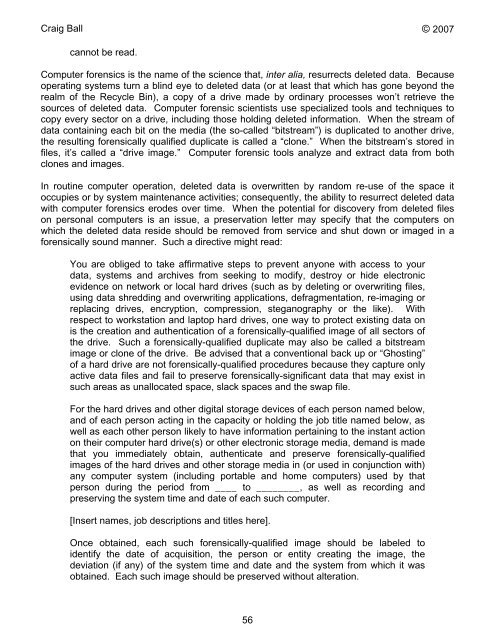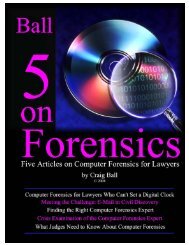Six Articles on Electronic - Craig Ball
Six Articles on Electronic - Craig Ball
Six Articles on Electronic - Craig Ball
Create successful ePaper yourself
Turn your PDF publications into a flip-book with our unique Google optimized e-Paper software.
<strong>Craig</strong> <strong>Ball</strong> © 2007<br />
cannot be read.<br />
Computer forensics is the name of the science that, inter alia, resurrects deleted data. Because<br />
operating systems turn a blind eye to deleted data (or at least that which has g<strong>on</strong>e bey<strong>on</strong>d the<br />
realm of the Recycle Bin), a copy of a drive made by ordinary processes w<strong>on</strong>’t retrieve the<br />
sources of deleted data. Computer forensic scientists use specialized tools and techniques to<br />
copy every sector <strong>on</strong> a drive, including those holding deleted informati<strong>on</strong>. When the stream of<br />
data c<strong>on</strong>taining each bit <strong>on</strong> the media (the so-called “bitstream”) is duplicated to another drive,<br />
the resulting forensically qualified duplicate is called a “cl<strong>on</strong>e.” When the bitstream’s stored in<br />
files, it’s called a “drive image.” Computer forensic tools analyze and extract data from both<br />
cl<strong>on</strong>es and images.<br />
In routine computer operati<strong>on</strong>, deleted data is overwritten by random re-use of the space it<br />
occupies or by system maintenance activities; c<strong>on</strong>sequently, the ability to resurrect deleted data<br />
with computer forensics erodes over time. When the potential for discovery from deleted files<br />
<strong>on</strong> pers<strong>on</strong>al computers is an issue, a preservati<strong>on</strong> letter may specify that the computers <strong>on</strong><br />
which the deleted data reside should be removed from service and shut down or imaged in a<br />
forensically sound manner. Such a directive might read:<br />
You are obliged to take affirmative steps to prevent any<strong>on</strong>e with access to your<br />
data, systems and archives from seeking to modify, destroy or hide electr<strong>on</strong>ic<br />
evidence <strong>on</strong> network or local hard drives (such as by deleting or overwriting files,<br />
using data shredding and overwriting applicati<strong>on</strong>s, defragmentati<strong>on</strong>, re-imaging or<br />
replacing drives, encrypti<strong>on</strong>, compressi<strong>on</strong>, steganography or the like). With<br />
respect to workstati<strong>on</strong> and laptop hard drives, <strong>on</strong>e way to protect existing data <strong>on</strong><br />
is the creati<strong>on</strong> and authenticati<strong>on</strong> of a forensically-qualified image of all sectors of<br />
the drive. Such a forensically-qualified duplicate may also be called a bitstream<br />
image or cl<strong>on</strong>e of the drive. Be advised that a c<strong>on</strong>venti<strong>on</strong>al back up or “Ghosting”<br />
of a hard drive are not forensically-qualified procedures because they capture <strong>on</strong>ly<br />
active data files and fail to preserve forensically-significant data that may exist in<br />
such areas as unallocated space, slack spaces and the swap file.<br />
For the hard drives and other digital storage devices of each pers<strong>on</strong> named below,<br />
and of each pers<strong>on</strong> acting in the capacity or holding the job title named below, as<br />
well as each other pers<strong>on</strong> likely to have informati<strong>on</strong> pertaining to the instant acti<strong>on</strong><br />
<strong>on</strong> their computer hard drive(s) or other electr<strong>on</strong>ic storage media, demand is made<br />
that you immediately obtain, authenticate and preserve forensically-qualified<br />
images of the hard drives and other storage media in (or used in c<strong>on</strong>juncti<strong>on</strong> with)<br />
any computer system (including portable and home computers) used by that<br />
pers<strong>on</strong> during the period from ____ to ________, as well as recording and<br />
preserving the system time and date of each such computer.<br />
[Insert names, job descripti<strong>on</strong>s and titles here].<br />
Once obtained, each such forensically-qualified image should be labeled to<br />
identify the date of acquisiti<strong>on</strong>, the pers<strong>on</strong> or entity creating the image, the<br />
deviati<strong>on</strong> (if any) of the system time and date and the system from which it was<br />
obtained. Each such image should be preserved without alterati<strong>on</strong>.<br />
56













